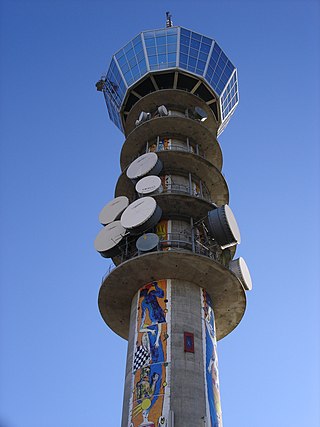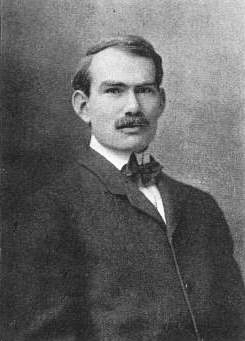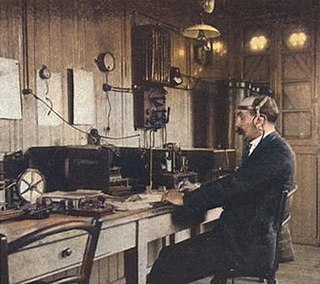
| |||
|---|---|---|---|
| +... |
The year 1904 in radio involved some significant events.

| |||
|---|---|---|---|
| +... |
The year 1904 in radio involved some significant events.

Guglielmo Giovanni Maria Marconi, 1st Marquess of Marconi was an Italian electrical engineer, inventor, physicist and politician known for his creation of a practical radio wave-based wireless telegraph system. This led to Marconi being credited as the inventor of radio and sharing the 1909 Nobel Prize in Physics with Karl Ferdinand Braun "in recognition of their contributions to the development of wireless telegraphy". His work laid the foundation for the development of radio, television and all modern wireless communication systems.

Sir John Ambrose Fleming was an English electrical engineer and physicist who invented the vacuum tube, designed the radio transmitter with which the first transatlantic radio transmission was made, and also established the right-hand rule used in physics.

The early history of radio is the history of technology that produces and uses radio instruments that use radio waves. Within the timeline of radio, many people contributed theory and inventions in what became radio. Radio development began as "wireless telegraphy". Later radio history increasingly involves matters of broadcasting.

Radio broadcasting is the broadcasting of audio (sound), sometimes with related metadata, by radio waves to radio receivers belonging to a public audience. In terrestrial radio broadcasting the radio waves are broadcast by a land-based radio station, while in satellite radio the radio waves are broadcast by a satellite in Earth orbit. To receive the content the listener must have a broadcast radio receiver (radio). Stations are often affiliated with a radio network that provides content in a common radio format, either in broadcast syndication or simulcast, or both. The encoding of a radio broadcast depends on whether it uses an analog or digital signal. Analog radio broadcasts use one of two types of radio wave modulation: amplitude modulation for AM radio, or frequency modulation for FM radio. Newer, digital radio stations transmit in several different digital audio standards, such as DAB, HD radio, or DRM.

David Sarnoff was a Russian and American businessman who played an important role in the American history of radio and television. He led RCA for most of his career in various capacities from shortly after its founding in 1919 until his retirement in 1970.
The British Broadcasting Company Limited (BBC) was a short-lived British commercial broadcasting company formed on 18 October 1922 by British and American electrical companies doing business in the United Kingdom. Licensed by the British General Post Office, its original office was located on the second floor of Magnet House, the GEC buildings in London and consisted of a room and a small antechamber.

Lee de Forest was an American inventor, electrical engineer and an early pioneer in electronics of fundamental importance. He invented the first practical electronic amplifier, the three-element "Audion" triode vacuum tube in 1906. This helped start the Electronic Age, and enabled the development of the electronic oscillator. These made radio broadcasting and long distance telephone lines possible, and led to the development of talking motion pictures, among countless other applications.

A spark-gap transmitter is an obsolete type of radio transmitter which generates radio waves by means of an electric spark. Spark-gap transmitters were the first type of radio transmitter, and were the main type used during the wireless telegraphy or "spark" era, the first three decades of radio, from 1887 to the end of World War I. German physicist Heinrich Hertz built the first experimental spark-gap transmitters in 1887, with which he proved the existence of radio waves and studied their properties.
The Marconi Company was a British telecommunications and engineering company founded by Italian inventor Guglielmo Marconi in 1897 which was a pioneer of wireless long distance communication and mass media broadcasting, eventually becoming one of the UK's most successful manufacturing companies.
KRTH is a commercial radio station that is licensed to Los Angeles, California, United States and serves the Greater Los Angeles area. The station is owned by Audacy, Inc. and broadcasts a classic hits format. KRTH's studios are located on Wilshire Boulevard in the Miracle Mile district of Los Angeles. The station's signal covers an extremely large area of Southern California due in part to its antenna location on Mt. Wilson. It can be heard as far south as San Diego, as far east as Moreno Valley, as far west as Santa Barbara, and as far north as Barstow. KRTH is the flagship station for the nationally syndicated program Rewind with Gary Bryan.

KIIS-FM is a commercial radio station licensed to Los Angeles, California, United States, and broadcasts to the Greater Los Angeles area. The station airs a contemporary hit radio format. Owned by iHeartMedia, KIIS-FM is the origin of the conglomerate's KISS-FM brand, and serves as the flagship station for the radio program On Air with Ryan Seacrest. KIIS-FM's studios are located in Burbank, while the station transmitter resides on Mount Wilson, north of Los Angeles.

KABC-TV is a television station in Los Angeles, California, United States, serving as the West Coast flagship of the ABC network. Owned and operated by the network's ABC Owned Television Stations division, the station maintains studios in the Grand Central Business Centre of Glendale, and its transmitter is located on Mount Wilson.

The invention of radio communication was preceded by many decades of establishing theoretical underpinnings, discovery and experimental investigation of radio waves, and engineering and technical developments related to their transmission and detection. These developments allowed Guglielmo Marconi to turn radio waves into a wireless communication system.

WILM is a news/talk AM radio station broadcasting in Wilmington, Delaware, United States. The station is owned by iHeartMedia. WILM is known as the station where radio and television talk show Joe Pyne developed the confrontational style now standard in radio and TV talk shows. Another well-known WILM personality was Tom Mees (ESPN) who worked at the station in the 1970s.
The timeline of radio lists within the history of radio, the technology and events that produced instruments that use radio waves and activities that people undertook. Later, the history is dominated by programming and contents, which is closer to general history.
KLAA is a commercial AM radio station licensed to the city of Orange, California, and broadcasting to the Greater Los Angeles Area. The station is owned by LAA 1, LLC, composed of the owners and executives of the Los Angeles Angels baseball team, and is held separately from the baseball club. KLAA's studios and offices are located on the grounds of Angel Stadium in Anaheim, California.

The Fleming valve, also called the Fleming oscillation valve, was a thermionic valve or vacuum tube invented in 1904 by English physicist John Ambrose Fleming as a detector for early radio receivers used in electromagnetic wireless telegraphy. It was the first practical vacuum tube and the first thermionic diode, a vacuum tube whose purpose is to conduct current in one direction and block current flowing in the opposite direction. The thermionic diode was later widely used as a rectifier — a device that converts alternating current (AC) into direct current (DC) — in the power supplies of a wide range of electronic devices, until beginning to be replaced by the selenium rectifier in the early 1930s and almost completely replaced by the semiconductor diode in the 1960s. The Fleming valve was the forerunner of all vacuum tubes, which dominated electronics for 50 years. The IEEE has described it as "one of the most important developments in the history of electronics", and it is on the List of IEEE Milestones for electrical engineering.
The year 1989 saw a number of significant events in radio broadcasting.

Pegeen Fitzgerald was an American radio personality perhaps best known for co-hosting The Fitzgeralds on radio in New York City.

The Marconi Wireless Telegraph Company of America was incorporated in 1899. It was established as a subsidiary of the British Marconi Company and held the U.S. and Cuban rights to Guglielmo Marconi's radio patents. American Marconi initially primarily operated high-powered land and transatlantic shipboard stations. In 1912, it acquired the extensive assets of the bankrupt United Wireless Telegraph Company, becoming the dominant radio communications provider in the United States.